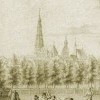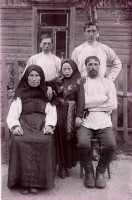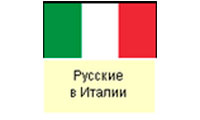The Ostsee Times and Old-Believers
At the end of the 18th and in the first half of the 19th Centuries the lands of present-day Latvia and Estonia were known as the Ostsee area. The origin of this term is German. The ruling powers there were German nobles and merchants. Despite the Ostsee being part of the Russian Empire, Russian legislation was not in force in these Baltic provinces. The official language in the region was German. It was possible to achieve a full education in German only. The Russian Orthodox minority chiefly made up of small tradesmen and workers were not engaged in any independent social activities. It was not uncommon for a few wealthy Orthodox merchants to adopt German culture and send their children to German schools.
It was a different situation for the Old Believers. The local Ostsee authorities were indifferent to the ancient split within the Russian Orthodox Church. Therefore the Old Believers felt secure in the Baltic provinces. They enjoyed religious freedom, living in their closed communities. At the same time they actively contributed to the economy of the provinces. The Old Believers of Riga built their own factories, hospital, almshouse, school and youth shelter; they owned many plots of land and other real estate. The Old Believers’ merchant class became a significant section of society. Rules passed by Russian Governor General, the Marquis Philippe Paulucci, in 1827 legalised the Community of Old Believers in Riga.
During the rule of Nicholas I (1825 – 1855) reaction was sharpened in all spheres of public life, including the state treatment of Old Believers. By the beginning of 1830 the wave of oppression had reached Riga. The ‘Rules of Paulucci’ were revoked; the school and the shelter were closed down and the hospital and almshouse were discontinued. Only one prayer house (the Old believers) remained in Riga, which had been given the name ‘Grebenshchikovsky’ (the Community of Old Believers in Riga perpetuated in its name the merchant Alexey Grebenschikov who had made generous donations for the development of the community). In 1837 the ‘United Faith’ was established. It was an artificial teaching having the purpose of bringing the Old Orthodox believers under the rule of the hierarchies of the official Russian Orthodox Church. The ‘United Faith’ allowed its congregation (the former Old Believers) to preserve the old rituals but they had to accept the priests appointed by Synod of the Orthodox Church. Since the state did not recognise Old Belief marriages, many well-off people, chiefly merchants, were forced to adopt, often conditionally, the ‘United Faith’.
The repressions of 1830 – 1850 had a damaging impact on the Old Belief, but they could not eradicate this religion and related communities. After the next tsar Alexander II came to the throne and began his reforms new Old Believer Societies were formed and prayer-houses were opened in places populated by Old Believers in Latgalia and Courland.
Антонина Заварина. Русское население Латвии (К истории поселения)
Иван Заволоко. О старообрядцах г.Риги
Александра Яковлева. Статистические данные касательно староверов в Прибалтийском крае, 19-й век
История староверов Риги в документах Латвийского Государственного исторического архива




















